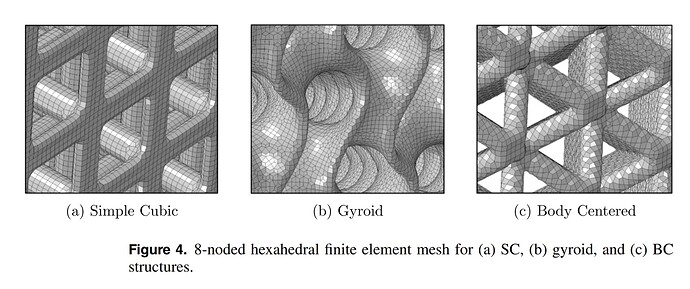Some interesting insight from a study on finite element mesh generation using Cubit 16.06.0. The study discusses using three-dimensional 8-noded hexahedral meshes (C3D8 elements in Abaqus) generated from STL files via the Sculpt overlay grid method.
It highlights the advantages of hexahedral elements over tetrahedral ones (C3D4) for modeling soft, nearly incompressible materials due to issues like volumetric locking, which artificially increases stiffness. While higher-order tetrahedral elements (C3D10) can reduce this effect, they tend to be computationally expensive.
You can read the paper here (see section 2.3.1): https://www.osti.gov/servlets/purl/2426737
Would love to hear your thoughts!
Finite element mesh generation. Mesh discretization was accomplished using Cubit version 16.06.0. Three-dimensional 8-noded hexahedral meshes (Element C3D8 within Abaqus) were created from STL files using the overlay grid method called Sculpt [44] (a companion application in Cubit version 16.06.0). We chose an 8-noded hexahedral element (C3D8) as it is commonly preferred over a 4-noded tetrahedral element (C3D4) when modeling soft, nearly incompressible materials because the first-order tetrahedral element exhibits a tendency for volumetric locking, commonly leading to an artificial increase in stiffness [45]. While higher order tetrahedral element (C3D10) can mitigate the tendency for volumetric locking, it tends to be computationally expensive in terms of memory requirement and time required for the analysis. From the mesh convergence study (refer to supplementary figure A1), a grid size of 0.15 mm was chosen based on a reasonable demonstration of the convergence in the overall stress–strain response. Two iterations of Laplacian smoothing were applied to improve element quality. The snapshot images of the hexahedral meshes for SC (3719 737 nodes & 2965 024 elements), gyroid (5003 296 nodes & 3849 212 elements), and BC (5094 691 nodes & 3803 232 elements) structures are shown in figure 4. To assess the quality of the FE mesh, the scaled Jacobian (sJ) measure for the generated meshes was calculated. A lower value of sJ indicates a poor-quality mesh, and sJ < 0 signifies an invalid or inverted mesh. Notably, the sJ of the elements in the generated mesh exceeds 0.2, which is a satisfactory threshold for accomplishing FE simulations without excessive mesh distortion or degeneration errors that are commonly encountered during large deformation scenarios.
